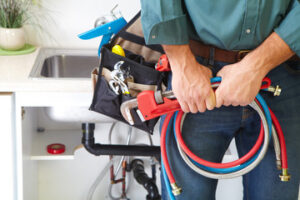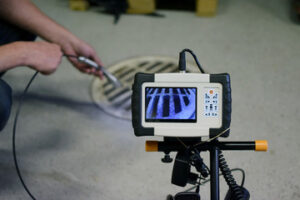Plumber are skilled tradespeople responsible for installing and repairing the pipes that provide water and heating/cooling systems. From fixing leaky taps to unclogging drains, they play a crucial role in keeping our modern lives running smoothly.

This career requires strong technical knowledge and manual dexterity, along with the ability to read blueprints and interpret building codes. They often work in small spaces and must be comfortable lifting heavy equipment.
A plumber installs plumbing fixtures and pipes that allow for the distribution of water, sewage and waste in homes and businesses. This work involves laying out and connecting piping systems as well as installing sinks, bathtubs, toilets, faucets, kitchen and bathroom appliances, washers for laundry, backflow preventers, septic tanks, and more. Many plumbers also have gas installation skills.
A qualified plumber will first read the blueprints to understand the layout of the piping system and ensure it meets all building regulations and safety standards. They will then cut holes through floors, walls, and ceilings to access the piping and make necessary adjustments. Using tools like pipe cutters and saws, they will join pipes together using techniques like soldering, solvent weld, push-fit fittings and compression fittings. Plumbers may also use welding equipment to join copper piping.
As they work, plumbers must be careful not to cut through electrical wires or other important parts of a home or business. If they do, it could lead to costly repairs or even an emergency shutdown of the entire plumbing system. In addition, plumbers must protect themselves from the potential risks of working with sewage and other hazardous materials. This includes wearing protective clothing and masks when handling such substances.
Once the piping is ready, plumbers will test it to ensure it works as intended. They will then add any necessary accessories and reconnect any existing ones. If the expansion is for a new kitchen or bath, they will also connect the appliances and lay down tile. When the project is finished, the plumber will clean up the area and restore any damaged surfaces.
Many homeowners choose to have their plumbing system installed by a professional rather than attempt it themselves. This eliminates the risk of error and saves time and money. Most plumbers offer a variety of services and can handle both commercial and residential plumbing. When choosing a plumber, it is important to consider their level of experience and whether they are certified and licensed in your state. You should also look for references and reviews from previous customers.
Repair
Plumbers often repair or replace toilets, sinks, faucets, tubs, showers, water heaters, and other household appliances. They can also handle more complex plumbing repairs like fixing or replacing sewer lines and backflow prevention devices. When a home or business owner notices a problem with one of these fixtures, they call a plumber to fix the issue quickly and correctly.
Plumber repairs can range from minor to major, depending on the situation. For example, a homeowner may have a clogged drain that a plumber can easily remove with the right tools. Another common plumbing repair is replacing worn out parts that are no longer working properly. This can include installing new faucet handles, replacing old washers and gaskets, or upgrading a home’s water shut-off valves to prevent leaks.
While some plumbing problems are easy for homeowners to diagnose and fix, others can be dangerous. For example, if a home or business owner notices leaking pipes, a plumber needs to be called immediately to prevent further damage and potential flooding. Plumbers can use a variety of tools to inspect the pipes for damage and clogs, including cameras that allow them to see inside of drains and pipes without digging up the entire system.
The most common repair job for a plumber is fixing clogged drains and sewer lines. When a homeowner suspects a clog, a plumber can use a drain snake or auger to clear out the blockage. Some clogs, however, are more serious and require more invasive methods to remove the blockage. For example, a plumber might need to dig up and replace the damaged section of a sewer line.
Leaking pipes are a serious problem that can lead to water damage in the house and mold growth. Many plumbers can repair small leaks with a simple patch, but larger leaks might require pipe replacement. Plumbers also repair or install backflow prevention devices to protect against contamination in drinking water and septic tank systems.
Plumbers can also repair or install household appliances like garbage disposals, dishwashers, washing machines, and toilets. They can even help a homeowner choose energy-efficient appliances to lower utility bills and reduce environmental impact.
Maintenance
Plumbers are responsible for the water, sewage and gas pipes that keep modern life functioning. They install, repair and maintain these vital systems in homes, businesses, factories and other commercial spaces. Their work often involves a lot of manual labour, so they need physical strength and agility as well as good hand-eye coordination to handle tools and parts. They also need excellent problem-solving skills to assess and fix issues quickly and efficiently.
The plumbing industry is highly competitive, so it’s important for plumbers to stay updated on new technologies and techniques. They should also have strong communication skills to effectively explain complicated issues to their customers in an easy-to-understand manner. Additionally, soft skills like customer service and teamwork are vital to ensuring successful outcomes for projects.
In addition to repairing existing plumbing, plumbers can also install water heaters and other appliances. They may also be involved in maintenance tasks, such as removing sediment from water tanks, or installing safety features like backflow valves. In some cases, plumbers may be required to work on large-scale projects, such as installing plumbing for a new building or industrial plant. These projects require them to collaborate with architects, engineers and construction teams to ensure the plumbing is properly integrated into the overall infrastructure of the space.
Whether they’re fixing a clogged drain or installing a new kitchen sink, plumbers use a wide range of tools to get the job done. They also need to be familiar with all relevant health and safety regulations. This is why many choose to undertake an apprenticeship or complete a vocational course before getting into the trade.
Plumbing problems can arise at any time, so it’s important to have a reliable plumber on call. Whether you’re facing a leaky pipe or an overflowing toilet, a qualified plumber will be able to respond quickly and fix the problem before it worsens. Keeping up with preventative maintenance is also a good idea, as this will help you avoid costly repairs in the future. For professional plumbers, it’s all about helping their customers enjoy a safe and comfortable home or workspace.
Customer Service
Plumbing is a customer service intensive profession. Customers are looking for plumbers to arrive promptly, listen to their problems and provide a solution. They also expect a reasonable price for the services provided and a clear understanding of what is required to address their issue. The best plumbers are able to convert first-time customers into repeat business and brand ambassadors through their professionalism, communication skills and the quality of their work.
The job duties of a plumber require physical strength and agility, manual dexterity, excellent hand-eye coordination and the ability to work in inclement weather conditions. Plumbing also requires a high level of technical knowledge and the ability to perform complex mechanical repairs, including installing and soldering plumbing joints, fixing leaky faucets, draining hot water tanks and clearing clogged drain lines. A plumber should also be knowledgeable about a variety of building construction materials and be able to make recommendations on which products and fixtures are most suitable for a particular customer.
Plumbers often need to have a licence in order to practice their trade. Licensing requirements vary by state but generally include passing an exam and completing two to five years of practical experience in the field. Plumbers must also regularly update their skills in order to stay abreast of changing technologies and industry practices.
A successful plumber can usually rely on referrals from satisfied clients as a significant source of new business. However, this doesn’t mean that a plumbing company can rest on its laurels and ignore new leads or opportunities for growth. A plumber should always be on the lookout for ways to improve their customer service and expand their offerings to existing customers.
Creating an effective plumber sales strategy is essential to a plumbing company’s long-term success. While there are many sales training courses available, the most effective sales tools for a plumber are simple, common sense tactics that focus on building trust and engagement with homeowners. This includes being prompt to respond to calls, demonstrating expertise in the plumbing field, explaining clearly the problem at hand and outlining the recommended solutions and associated costs. It’s important to follow up with customers after each service call and ask if they are happy with the outcome of the work and any suggestions for future improvements.

